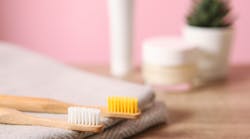Nature has repeatedly shown us its self-healing capabilities. We know that if human existence disappeared, plants and trees would take ownership of the land once again. If we scrape our arm, our blood platelets rush to clot the area, form a scab, and seal back up. The components of our bodies are created in a way that they can withstand a certain extent of injuries and cyclically attempt to repair anything that threatens survival.
The world we live in comes with external factors that can cause injury to the body, some of which are outside our control and some within it. Our bodies do the best they can depending on the current state they are in to mend any weaknesses and remain functioning. As the entryway to the body and the starting point of digestion, the mouth is vulnerable to constant attacks from various sources. An ingredient called hydroxyapatite (HAP), the main constituent of tooth enamel and bone, has been making a statement in the realm of tooth remineralization.
The type of food we eat, the way we cleanse the mouth, the act of smoking, drinking alcohol, breathing through the mouth, contact with certain chemicals, and chronic stress are merely some of the factors that contribute not only to the health of the mouth but to the health of the body. These factors may repeatedly cause the pH of the mouth to fluctuate and increase the risk for tooth decay. By placing HAP back on the teeth, we are replenishing the very material teeth are composed of, aiding in tooth remineralization.
Related reading:
Nano-hydroxyapatite in dental products: Better than fluoride?
Dentinal hypersensitivity: Common causes and possible solutions
As a form of calcium that is naturally occurring, it is how our teeth are formed (97% of our tooth enamel and 70% of our tooth dentin); HAP should be a no-brainer when it comes to substances able to remineralize our teeth. It is also the main component in our bones and is commonly used in osteopathic medicine for bone repair as it stimulates osteoblasts (bone-creating cells). Using HAP in oral care products may be an underexplored, long-awaited revelation in the dental industry.
Benefits of hydroxyapatite
The benefits of this ingredient being biomimetic are that once we place it on the teeth, the body knows what to do with it as it is already a familiar component. The small particles adhere to the tooth structure and fill in the weaker, demineralized areas, binding to the tooth and creating a stronger surface. This can also decrease sensitivity and give a whiter appearance to the teeth. For maximum benefit, it is recommended to leave the toothpaste on the teeth and not rinse it out. HAP is also nontoxic; if swallowed, there are no worries, and it is also safe for children to use.1
We have been accustomed to using and recommending fluoride products, but why can’t we be open to something different—especially when there is scientific evidence to back it up? With dental caries being one the most preventable diseases in the world and fluoride ingestion being a concern, particularly for children, what can we turn to? A need for effective fluoride-free products is prevailing, and HAP has shown itself to be that rising star.
Nano- and microhydroxyapatite
There are two types of HAP: nano and micro. Nano-HAP particles have particle sizes between 20 and 80 nanometers, while micro-HAP-sized particles are 5 to 10 microns long.2 There are toothpaste brands on the market with both sizes of particles. One of the main differences is that nano-HAP is usually synthetic and micro-HAP is usually from natural sources, such as cow bovine. Nano-HAP has been found to be a better remedy for those who suffer from tooth sensitivity since the particles are smaller and can grab onto more surface area, but both have shown promising effects on tooth sensitivity.3 It may be hard to grasp for those die-hard fluoride advocates, but HAP has been shown time and time again to be just as effective as its long-lived counterpart.
It’s not that fluoride isn’t effective; it’s been proven to be over years of studies and has shown great success in decreased rates of decay.4 Nonetheless, with the ever-growing movement of root-caused medicine, people are starting to want alternatives to products with the potential to cause harm. For example, a bottle of toothpaste with fluoride in it must carry a warning label in case a child swallows more than is recommended.5 In addition, there may be fluoride in the water, and a child may also get fluoride varnish at the dentist, along with ingesting prescribed fluoride supplements. Even so, those kids may still end up with tooth decay due to other factors such as diet, airway, or myofunctional issues. It’s been shown that a particular type of fluoride, called stannous fluoride, kills the cavity-causing bacteria in the mouth, but it also kills some of the beneficial bacteria.⁶ This can disrupt the oral microbiome, which leaves room for other oral health imbalances. HAP doesn’t kill bacteria; it just prevents harmful bacteria from attaching.7 Clinicians should educate parents about these possible components that lead to tooth decay before defaulting to fluoride. We should suggest options as to what will work best for the child so parents can make an informed decision.
How does HAP work?
HAP works by binding to the tooth surface and rebuilds areas of demineralization. It naturally contains calcium and phosphate ions, which are crucial components for the remineralization of enamel. Research has found HAP may penetrate to deeper layers of enamel further than fluoride and can reduce bacterial colonization.8 Another study compared HAP to chlorhexidine mouthwash and found it to be just as effective at reducing bacterial colonization, only without killing any bacteria and instead repelling bacteria from enamel. Chlorhexidine works by killing bacteria, which creates dysbiosis of the oral microbiome.9 This makes HAP a promising biomimetic active ingredient for reducing dental caries.
For maximum benefit, HAP toothpaste should be left on the teeth and not rinsed. The same may be said for fluoride, but this creates a greater risk of swallowing more fluoride than recommended.10
Those who believe there is only one popular remedy for cavities may have the urge to dismiss the thought of something new emerging in their well-known world of dentistry. Learning to adapt and staying open-minded is the most effective way to not fall behind in our ever-evolving world. Professionals can share an alternative with those who decline fluoride and still feel good about creating a positive prevention strategy for them.
It’s important to remember that cavities are preventable. A colorful diet, proper airway function, and healthy lifestyle habits are imperative factors to decrease cavities. Fluoride has been the go-to resource for those struggling with cavities, as well as a reliable prevention method. A new alternative is gaining traction that deserves some more recognition. Hydroxyapatite toothpaste is here, and it’s part of who we are (literally). What shouldn’t be taken lightly is its capability to successfully remineralize tooth enamel due to its biomimetic features, decreasing the occurrence of cavities. It is encouraging to know that there are now numerous ways to approach one of the most preventable diseases on the planet.
Author’s note: I’ve teamed up with Dr. Mark Burhenne, also known as “Ask the Dentist,” to create a one-stop resource of scientific studies done on HAP. Check us out on theFlossophy.
Editor's note: This article appeared in the September 2022 print edition of RDH magazine. Dental hygienists in North America are eligible for a complimentary print subscription. Sign up here.
References
- Remya NS, Syama S, Sabareeswaran A, Mohanan PV. Investigation of chronic toxicity of hydroxyapatite nanoparticles administered orally for one year in wistar rats. C. Mater Sci Eng C Mater Biol Appl. 2017;76:518-527. doi:10.1016/j.msec.2017.03.076
- Legeros RZ, Legeros JP. Hydroxyapatite. Nano Today. 2014. Accessed February 18, 2022. https://www.sciencedirect.com/topics/chemical-engineering/hydroxyapatite
- Shreya S, Ramreddy Y, Karunakar S. Comparative evaluation of hydroxyapatite, potassium nitrate and sodium monofluorophosphate in office desensitizing agents—a double blinded randomized controlled clinical trial. J Oral Hyg Health. 2013;1:104. doi:10.4172/2332-0702.1000104
- Kanduti D, Sterbenk P, Artnik B. Fluoride: a review of use and effects on health. Mater Sociomed. 2016;28(2):133-137. doi:10.5455/msm.2016.28.133-137
- Johnston NR, Strobel SA. Principles of fluoride toxicity and the cellular response: a review. Arch Toxicol. 2020;94(4):1051-1069. doi:10.1007/s00204-020-02687-5
- Mitchell J. The other fluoride: The benefits of stannous fluoride. Tufts Now. March 20, 2013. Accessed August 4, 2022. https://now.tufts.edu/2013/03/20/other-fluoride-benefits-stannous-fluoride
- Meyer F, Enax J. Hydroxyapatite in oral biofilm management. Eur J Dent. 2019;13(2):287-290. doi:10.1055/s-0039-1695657
- Amaechi BT, AbdulAzees PA, Alshareif DO, et al. Comparative efficacy of hydroxyapatite and fluoride toothpaste for prevention and remineralization of dental caries in children. BDJ Open. 2019;5:18. doi:10.1038/s41405-019-0026-8
- Kensche A, Holder C, Basche S, Tahan N, Hannig C, Hannig M. Efficacy of a mouthrinse based on hydroxyapatite to reduce initial bacterial colonisation in situ. Arch Oral Biol. 2017;80:18-26. doi:10.1016/j.archoralbio.2017.03.013
- “Spit don’t rinse” for better oral health. Oral Health Foundation. June 6, 2016. Accessed February 19, 2022. https://www.dentalhealth.org/news/spit-dont-rinse-for-better-oral-health







